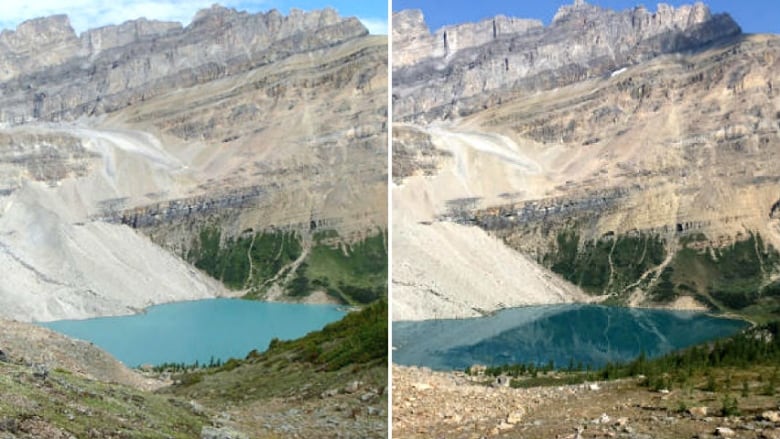'Brilliant blues' of mountain lakes change as glaciers shrink, new research suggests
Lake in Banff National Park goes from emerald to sapphire blue in 2 years

Shimmering mountain lakes will start to show new colours in coming years, new research suggests.
A scientific duo has wrapped up seven years of measuring how lakes are changing due to glaciers melting. They've found that, as glaciers shrink, the lakes are changing colour and rapidly.
"They're very well known for the really brilliant blues," researcher Janet Fischer told the Calgary Eyeopener on Tuesday. "The blue is changing from more of a brilliant turquoise blue-green to a richer sapphire blue."
Fischer, a biologist from Franklin & Marshall College in Pennsylvania, is spending a year atthe University of Calgary's biogeoscience institute. She's work on a projectwith her husband and scientific partner, Mark Olson.They're speaking at Banff Senior Centre on Tuesday evening as part of theBow Valley Naturalists Speaker Series.
Shrinking glaciers changelakes
The pair say their research suggests lakes are being affected by the glaciers shrinking as the climate changes. It means that due to climate change, future generations may not be able to enjoy the same beautiful hues of mountain lakes, she said.
Glacial-fed alpine lakes in the Rocky Mountains are among the clearest in the world. Fine rock dust, produced by massive glaciers rubbing against bedrock, stays suspended in the water, reflecting light and creating the turquoise colours that Moraine Lake and Lake Louise are known for.
Listen to the full Calgary Eyeopener interview here:
As glaciers disappear, less fine-grained silt is being produced. Thatturns lakes less blue, and more transparent.
The couple's study has measured how lakes are losing their "turbidity," the cloudiness caused by the concentration of that glacier-created silt. Less silt makesthe lakes more transparent.
The current "almost psychedelic" opaque turquoise blue-green colour of these lakes will shift to a richer, deeper blue as the water is clearer with fewer particles, she said.
Rapidly changing Banff lake
The change is most dramatic at Zigadenus Lake, which is in the Skoki region northeast of Lake Louise in Banff National Park.
In 2015, a photo shows an emerald lake. In 2017, that same lake looks to be a more transparent sapphire blue.

That lake is losing turbidity by roughly 15.8 per cent a year the faster of the mountain lakes observed by Fischer and Olson.
The changes are expected to become more dramatic as time goes on, Fischer said. A 2018 study predicted 80 per cent of mountain glaciers in Western Canada will disappear in the next 50 years. Those glaciers directly feed the lakes in her study, she said.
For their study,Fischer and Olson compared eight glacial-fed lakes with nine non-glacial fed lakes. The ones fed by glaciers have shown statistically significant decreases in turbidity and increases in transparency, Fischer said. They hope to publish a paper on these specific findings soon.
With files from the Calgary Eyeopener.












_(720p).jpg)


 OFFICIAL HD MUSIC VIDEO.jpg)
.jpg)



























































































